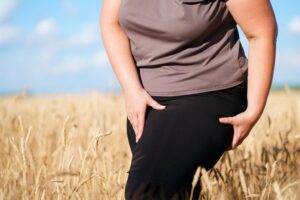Lipedema is a condition that affects the fatty tissue in the body. When there is an accumulation of fat, it can also result in losses in muscle mass and strength as well as muscle atrophy, which can lead to mobility issues. It worsens when someone starts gaining weight from time to time, impacting their legs and calves most often.
Lipedema mainly affects the thighs and buttocks, which usually significantly impacts the sufferer’s ability to move around without discomfort. The most common cause of lipedema is unknown, although it is believed there could be a genetic predisposition to this disorder. It is also related to various sex hormone disorders, such as hypothyroidism, Cushing’s syndrome, and polycystic ovary syndrome.
Most Commonly Experienced Mobility Issues Caused by Lipedema
 Weakness in the Quadriceps
Weakness in the Quadriceps
Weakness in the quadriceps is the most common problem experienced by those who suffer from lipedema. It occurs because they can never strengthen this muscle group, as is required when walking or running. Weak quadriceps muscles may also make it difficult for these people to pull up their legs, which can cause them to tire quickly.
As a result, they may lead a sedentary lifestyle. It is, therefore, necessary for a person with lipedema to engage in physical activity more often to avoid the development of problems regarding mobility.
Swelling and Fluid Associated with Lipedema
When fatty tissue becomes too large, it may cause the skin to swell, in some cases permanently. It is known as lipoatrophy or fatty atrophy. As a result of this condition, people with lipedema may struggle to walk because they feel soreness while their legs are stretched out.
Armpits, groin, and inner thighs can also become swollen if fat tissue is trapped in these areas. Furthermore, these people will experience pain when their legs are pulled upwards from the protruding fat tissue on the buttocks and thighs. Therefore, they must check the symptoms regularly and consult a physician if they notice any swelling or other changes in the body.
Pain in the Ankles
If the fatty tissue holding down a person’s feet becomes too heavy, it can result in pain in their ankles. It is because the pressure is exerted on them all the time. To alleviate this, these people may need to buy special shoes designed to be worn with inner soles or ankle straps.
Another cause of ankle pain is from wearing high heels. The higher a person’s heels are, the greater the pressure will be exerted on their feet and ankles, causing discomfort and severe pain when walking or running. On average, only about 10% of women who habitually wear high heels experience pain in their feet due to wearing them regularly for several years.
Weakness in the Achilles tendon
It is a common problem for people with lipedema as an increase in fatty tissue can also cause a weakening of their Achilles tendon. This condition is resolved if these people wear heels that are not too high, have low heels, or have ankle straps. Wearing padding around the Achilles tendons helps reduce pain and pressure on this particular muscle group.
It is also important to note that despite the presence of fatty tissue, lipedema may not affect muscular strength. It is because it primarily affects women aged 20-50, and it could also be present in children.
Reduction in Blood Circulation in the Ankles
The ankles can become swollen and even lose their color if blood circulation is impeded by lipedema. It can be prevented if people with this condition wear shoes that do not squeeze their feet too tight. They should also ensure that they use sunscreen if they walk for long periods or are exposed to the sun for long periods. It is also necessary to wear ankle straps or inner soles to ease pressure on the ankles.
Compression garments for Lipedema can help reduce reduce fluid buildup and discomfort.
Weakness in the Gastrocnemius:
The muscles that are used when walking are the gastrocnemius and soleus. Weakness in a person’s gastrocnemius can cause them to walk with a slow, tired gait. On the other hand, it can make it difficult for someone to run as they have insufficient strength in their calves and feet. It is most common in women, with only 15% not experiencing any weakness in the calf muscles.
Weakness in the Abdominal Muscles
Many people with lipedema have a significant accumulation of fat tissue around their abdominal area, making it difficult for them to breathe correctly or walk properly. For example, these people often experience a feeling of gasping for air when they exercise or perform any physical activity.
Abdominal muscles may also become weakened due to this adipose tissue growth, making it difficult for them to take deep breaths or lie flat on their back when sleeping. Therefore, they must engage in physical activity regularly so that their abdominal area does not become too swollen.
Decreased Flexibility in the Abdominal Area
When fatty tissue becomes too large, it can cause the abdominal muscles to become weak. It can make it difficult for someone to sit or stand up straight and close their legs while sitting or lying on their back during sleep because they feel pain. As a result, they may develop a hunched back, which can make them look shorter.
Decreased Flexibility in the Ankles
As mentioned earlier, an increase in fat tissue can make it difficult for people with lipedema to get their feet under them when they stand or walk. As a result, they may need to use special shoes and support devices to help solve this problem. It is, therefore, essential to ensure that the soles of their boots are flexible enough, especially if they tend to wear long pants. Padding on the ankles during physical activity can help resolve this problem.
Swelling in the Flexor Hallucis Longus
It is a condition that causes someone’s feet to turn outwards. Lipedema can contribute to this condition, resulting in excess adipose tissue accumulation around the inner ankle and heel area. It is one of the reasons why people with lipedema often walk on their toes and have difficulties straightening their feet for extended periods of standing or walking. Therefore, they must wear shoes designed for people with high heels and have inner soles to prevent this condition from worsening.
Decreased Flexibility in the Thighs
It can be difficult for people with lipedema to open their knees while standing or walking, making it difficult for them to walk upstairs or run slowly across a room. It is because the movement of the legs, which occurs when they walk, involves bringing the thigh towards the abdomen.
Women with lipedema often experience pain in their thighs due to this problem. When people with lipedema have a significant accumulation of fat tissue around their thighs, it can become increasingly difficult for them to walk upstairs. It is why it is essential for them to wear shoes that are not too tight or high-heeled and use support devices under their knees while walking or exercising.
Pain in the Feet
An increase in fat tissue can make women with lipedema feel pain and tenderness in the soles of their feet when they walk or run. If a person does not wear shoes with proper arch support, it may also cause them to develop flat feet due to long-term use.
People should always visit a doctor if they experience any of these symptoms. A Lipedema Specialist will then be able to determine the best course of treatment. More importantly, this will ensure that they remain healthy and continue experiencing no pain or discomfort.
For inquiries, please email our office at [email protected], and we will send a quick reply will be sent about your condition. If you require a personal consultation that requires an appointment, please call the office today at 416-782-5353.


